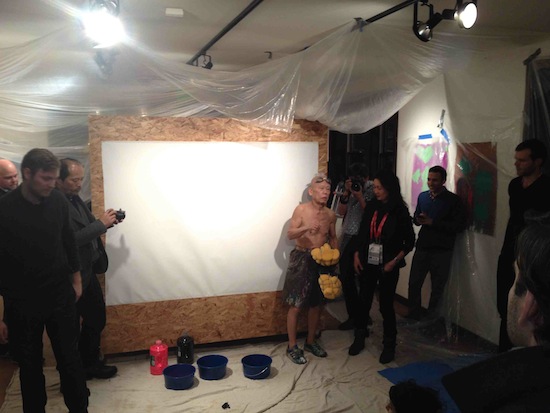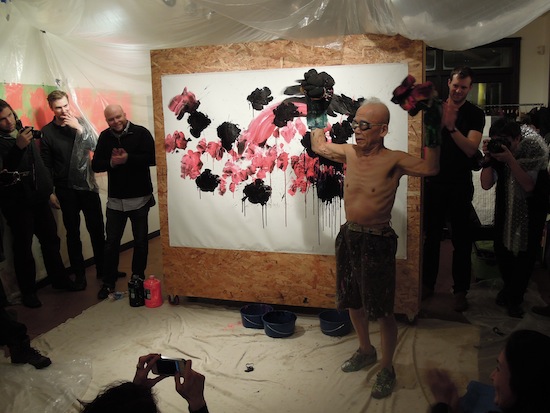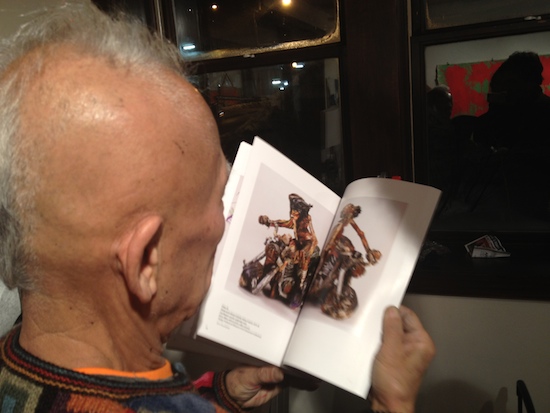Sundance 2013: An 81-Year-Old, Shirtless, Japanese Artist Boxes With a Canvas
Published in LA WEEKLY
Bare-chested, in shorts and goggles, an 81-year-old Japanese man stood in front of us. It looked like we were about to watch him go swimming. But it was zero degrees outside, and we were in an art gallery during the Sundance Film Festival last Saturday. It turns out films aren’t the only things to see in Park City: we were about to watch a round of paint-boxing.
Ushio Shinohara, the shirtless octogenarian, one of the subjects of Sundance documentary Cutie and the Boxer, created the art of paint-boxing in 1960. “At that time, he didn’t have anything, so it was just a piece of paper on a wall,” the interpreter at the gallery translates from Shinohara’s Japanese.
In an interview later, Shinohara elaborates in what he calls his “not very good” English, “Boxing gloves very expensive in 1960, I can’t buy. Canvas, I can’t buy.” His secret? “Garbage.” Shinohara recounts how he and his peers were inspired by their contemporary, Robert Rauschenberg, a master of found-object work. “He’s a king of junk for Japanese young artists. Every young artist get free [supplies].”
Back in the intro, he remarks through the translator, “Since boxing is not very popular in New York right now [boxing gloves are] down from $55 to $20.” The audience of festivalgoers laughs at his current good fortune, though perhaps some of that is nervous laughter. The crowd is huddled together on steps inside the gallery, many trying to get as close as possible and others hanging back just a bit, iPhones held up like periscopes, as they protect themselves from the splattering paint we’ve been warned about (though we’re assured it washes out of clothes). Shinohara attaches sponges to his bargain boxing gloves, dips them in tubs of paint, then punches recklessly at the canvas, sending paint-droplets, black and hot pink, flying in our direction.
Paint boxing requires no adversary, but it does require an audience. Interestingly, we had to be on the list to get in, but if we hadn’t shown up, the performance wouldn’t have worked. According to Shinohara, he only has a responsibility of 50 percent. The audience has the other 50 percent of responsibility, “watching and thinking.”
Shinohara’s translator relays that in 1960, “Nobody at that time, including himself, considered it art.” When later asked what made him accept his work as art, Shinohara explains, “I’m a town boy, a Tokyo boy. I always need an audience. People watching me, then I accept it.”
Shinohara does not have any favorite paint-boxing works — he says it depends on the audience. “The audience creates more possibilities.”
At the end of the performance, when he stopped throwing punches, I had to wonder if I, as an audience member, wasn’t working hard enough. I wanted more. But encores aren’t a part of paint boxing.
Shinohara’s work has no duration or size requirements. “It’s only about hitting the board,” he says. His job is simply to start punching on the right hand side of canvas, heading towards the left. “Depends on canvas size. Not my size, not my ideas. Bam bam bam bam bam.”
Some art can be hard to describe, but Shinohara’s onomatopoetic summary does his work justice. He categorizes it as “action painting,” a genre that includes Jackson Pollock’s paint-flinging. It also recalls even more aggressive processes, like Niki de Saint Phalle’s early 1960s “shooting paintings,” featured in MOCA’s recent exhibit “Destroying the Picture,” which were created by shooting guns at at bladders filled with paint.
And, whereas part of the audience’s responsibility is to think, for him, the interpreter says, “The main thing is to have nothing in his mind. Everything about concept and art goes out of his mind.”
That level of focus is indeed reminiscent of an athlete, and makes one wonder — if his art knowledge has vacated his brain, might his boxing knowledge remain behind? Not so. Shinohara was not a fan of boxing prior to inventing his art and, while it may be hard to believe after his right hook had that acrylic lying down, Shinohara has, in fact, never learned how to box. “I’m not Mike Tyson. Very quiet,” he leans in and tells us. Paint-boxing’s main similarity to its sport of origin — other than its execution in front of an audience — is that, “Speed is more important…Fast. Quick, quick.”
Even in the early days, Shinohara’s work was not widely recognized. His translator says, however, that ” there was one photographer in Japan, William Klein, who did a book on Moscow, Tokyo and New York. Ushio was presented in William Klein’s book and therefore that is where he is today.” Sort of. He goes on to say, “And ever since then, nothing happened for forty years.”
Shinohara later tells us, in the interview, that he was doing his boxing painting in 1961 and 1962 and then stopped, “because nobody wants that.” It wasn’t until the National Museum of Art in Osaka picked up his art in 1994 that he was visible again.
During those middle years, he did paintings, drawings and sculpture. As he walked us through his book, you could see recurring motifs — motorcycles, frogs, ladies. But no tableau. “Canvas painting is all tableau,” he tells us, describing tableau as “bananas… and thinking… good or bad… I don’t care.”
He hates tableau. But he loves being back in the proverbial ring. And Zachary Heinzerling’s documentary — which tells the story of his art and his 40-year mariage to his wife, Noriko — has put him there. “This is a special year,” Shinohara tells us, of 2013. “This is a comeback year.”
Additional reporting by Zachary Pincus-Roth, on Twitter at @zpincusroth
SEE VIDEO OF PAINT-BOXING AT LAWEEKLY.COM
Follow me on Twitter at @eveweston, and for more arts news follow us at @LAWeeklyArts and like us on Facebook.



Discuss - No Comments